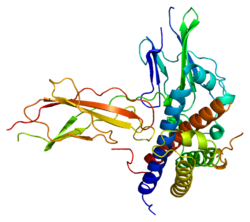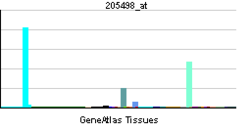生长激素受体
生长激素受体(英語:Growth hormone receptor)是一种由人类基因GHR 编码的蛋白质[1],GHR的直系同源物[2]广泛存在于各种哺乳动物中。
此基因编码的蛋白是结合生长激素的跨膜受体。
相互作用
[编辑]生长激素受体能与SGTA[3]、PTPN11[4][5]、JAK激酶2[6][7][8]、SOCS1[9]和CISH[9]发生交互作用。
进化
[编辑]GHR 基因曾作为动物核DNA系统发育标记[2],对其10号外显子基因多态性的探究第一次阐释了啮齿目主要类群间的亲缘关系[10][11][12]。GHR也用于较低阶元的分类,在鼠总科[13][14]、八齿鼠科[15]、田鼠亞科[16]、鼠亚科[17]、白足鼠屬[18]等啮齿动物,及熊型總科[19]、猫科[20]等肉食动物以及皮翼目[21]的分类上有重要作用。GHR的9号内含子也用于阐释鼬科[22]、鬣狗科[23]的系统发生。
拮抗剂
[编辑]参考文献
[编辑]- ^ Entrez Gene: GHR growth hormone receptor.
- ^ 2.0 2.1 OrthoMaM phylogenetic marker: GHR coding sequence. [2014-02-04]. (原始内容存档于2015-09-24).
- ^ Schantl, Julia A; Roza Marcel, De Jong Ad P, Strous Ger J. Small glutamine-rich tetratricopeptide repeat-containing protein (SGT) interacts with the ubiquitin-dependent endocytosis (UbE) motif of the growth hormone receptor. Biochem. J. (England). August 2003, 373 (Pt 3): 855–63. ISSN 0264-6021. PMC 1223544
 . PMID 12735788. doi:10.1042/BJ20021591.
. PMID 12735788. doi:10.1042/BJ20021591.
- ^ Stofega, M R; Herrington J, Billestrup N, Carter-Su C. Mutation of the SHP-2 binding site in growth hormone (GH) receptor prolongs GH-promoted tyrosyl phosphorylation of GH receptor, JAK2, and STAT5B. Mol. Endocrinol. (UNITED STATES). September 2000, 14 (9): 1338–50. ISSN 0888-8809. PMID 10976913. doi:10.1210/me.14.9.1338.
- ^ Moutoussamy, S; Renaudie F, Lago F, Kelly P A, Finidori J. Grb10 identified as a potential regulator of growth hormone (GH) signaling by cloning of GH receptor target proteins. J. Biol. Chem. (UNITED STATES). June 1998, 273 (26): 15906–12. ISSN 0021-9258. PMID 9632636. doi:10.1074/jbc.273.26.15906.
- ^ Frank, S J; Yi W, Zhao Y, Goldsmith J F, Gilliland G, Jiang J, Sakai I, Kraft A S. Regions of the JAK2 tyrosine kinase required for coupling to the growth hormone receptor. J. Biol. Chem. (UNITED STATES). June 1995, 270 (24): 14776–85. ISSN 0021-9258. PMID 7540178. doi:10.1074/jbc.270.24.14776.
- ^ VanderKuur, J A; Wang X, Zhang L, Campbell G S, Allevato G, Billestrup N, Norstedt G, Carter-Su C. Domains of the growth hormone receptor required for association and activation of JAK2 tyrosine kinase. J. Biol. Chem. (UNITED STATES). August 1994, 269 (34): 21709–17. ISSN 0021-9258. PMID 8063815.
- ^ Hellgren, G; Jansson J O, Carlsson L M, Carlsson B. The growth hormone receptor associates with Jak1, Jak2 and Tyk2 in human liver. Growth Horm. IGF Res. (SCOTLAND). June 1999, 9 (3): 212–8. ISSN 1096-6374. PMID 10502458. doi:10.1054/ghir.1999.0111.
- ^ 9.0 9.1 Ram, P A; Waxman D J. SOCS/CIS protein inhibition of growth hormone-stimulated STAT5 signaling by multiple mechanisms. J. Biol. Chem. (UNITED STATES). December 1999, 274 (50): 35553–61. ISSN 0021-9258. PMID 10585430. doi:10.1074/jbc.274.50.35553.
- ^ Adkins RM, Gelke EL, Rowe D, Honeycutt RL. Molecular phylogeny and divergence time estimates for major rodent groups: evidence from multiple genes.. Mol Biol Evol. 2001, 18 (5): 777–791. PMID 11319262. doi:10.1093/oxfordjournals.molbev.a003860.
- ^ Adkins R. M., Walton A. H. & Honeycutt R. L. Higher-level systematics of rodents and divergence time estimates based on two congruent nuclear genes. Mol. Phylogenet. Evol. 2003, 26 (3): 409–420. PMID 12644400. doi:10.1016/S1055-7903(02)00304-4.
- ^ Blanga-Kanfi S., Miranda H., Penn O., Pupko T., DeBry R. W. & Huchon D. Rodent phylogeny revised: analysis of six nuclear genes from all major rodent clades. BMC Evol. Biol. 2009, 9: 71 [2014-02-04]. PMC 2674048
 . PMID 19341461. doi:10.1186/1471-2148-9-71. (原始内容存档于2015-09-23).
. PMID 19341461. doi:10.1186/1471-2148-9-71. (原始内容存档于2015-09-23).
- ^ Steppan S. J., Adkins R. M. & Anderson J. Phylogeny and divergence-date estimates of rapid radiations in muroid rodents based on multiple nuclear genes. Syst. Biol. 2004, 53 (4): 533–553. PMID 15371245. doi:10.1080/10635150490468701.
- ^ Rowe K. C., Reno M. L., Richmond D. M., Adkins R. M. & Steppan S. J. Pliocene colonization and adaptive radiations in Australia and New Guinea (Sahul): multilocus systematics of the old endemic rodents (Muroidea: Murinae). Mol. Phylogenet. Evol. 2008, 47 (1): 84–101. PMID 18313945. doi:10.1016/j.ympev.2008.01.001.
- ^ Honeycutt R. L., Rowe D. L. & Gallardo M. H. Molecular systematics of the South American caviomorph rodents: relationships among species and genera in the family Octodontidae. Mol. Phylogenet. Evol. 2003, 26 (3): 476–489. PMID 12644405. doi:10.1016/S1055-7903(02)00368-8.
- ^ Galewski T., Tilak M., Sanchez S., Chevret P., Paradis E. & Douzery E. J. P. The evolutionary radiation of Arvicolinae rodents (voles and lemmings): relative contribution of nuclear and mitochondrial DNA phylogenies. BMC Evol. Biol. 2006, 6: 80 [2014-02-04]. PMC 1618403
 . PMID 17029633. doi:10.1186/1471-2148-6-80. (原始内容存档于2015-11-15).
. PMID 17029633. doi:10.1186/1471-2148-6-80. (原始内容存档于2015-11-15).
- ^ Lecompte E., Aplin K., Denys C., Catzeflis F., Chades M. & Chevret P. Phylogeny and biogeography of African Murinae based on mitochondrial and nuclear gene sequences, with a new tribal classification of the subfamily. BMC Evol. Biol. 2008, 8: 199 [2014-02-04]. PMC 2490707
 . PMID 18616808. doi:10.1186/1471-2148-8-199. (原始内容存档于2015-11-30).
. PMID 18616808. doi:10.1186/1471-2148-8-199. (原始内容存档于2015-11-30).
- ^ Miller J. R. & Engstrom M. D. The relationships of major lineages within peromyscine rodents: a molecular phylogenetic hypothesis and systematic reappraisal. J. Mammal. 2008, 89 (5): 1279–1295. doi:10.1644/07-MAMM-A-195.1.
- ^ Fulton T. L. & Strobeck C. Molecular phylogeny of the Arctoidea (Carnivora): effect of missing data on supertree and supermatrix analyses of multiple gene data sets. Mol. Phylogenet. Evol. 2006, 41 (1): 165–181. PMID 16814570. doi:10.1016/j.ympev.2006.05.025.
- ^ Johnson W. E., Eizirik E., Pecon-Slattery J., Murphy W. J., Antunes A., Teeling E. & O'Brien S. J. The late Miocene radiation of modern Felidae: a genetic assessment. Science. 2006, 311 (5757): 73–77. PMID 16400146. doi:10.1126/science.1122277.
- ^ Janecka J. E., Helgen K. M., Lim N. T., Baba M., Izawa M., Boeadi & Murphy W. J. Evidence for multiple species of Sunda colugo. Curr. Biol. 2008, 18 (21): R1001–R1002. PMID 19000793. doi:10.1016/j.cub.2008.09.005.
- ^ Koepfli K. P. & Wayne R. K. Type I STS markers are more informative than cytochrome B in phylogenetic reconstruction of the Mustelidae (Mammalia: Carnivora). Syst. Biol. 2003, 52 (5): 571–593. PMID 14530127. doi:10.1080/10635150390235368.
- ^ Koepfli K. P., Jenks S. M., Eizirik E., Zahirpour T., Van Valkenburgh B. & Wayne R. K. Molecular systematics of the Hyaenidae: relationships of a relictual lineage resolved by a molecular supermatrix. Mol. Phylogenet. Evol. 2006, 38 (3): 603–620. PMID 16503281. doi:10.1016/j.ympev.2005.10.017.
外部链接
[编辑]- 醫學主題詞表(MeSH):Somatotropin+receptors
- Illustration at nih.gov (页面存档备份,存于互联网档案馆)
- Overview (页面存档备份,存于互联网档案馆)
- Growth Hormone Receptor (页面存档备份,存于互联网档案馆): Molecule of the Month by Shuchismita Dutta and David Goodsell (April 2004)

